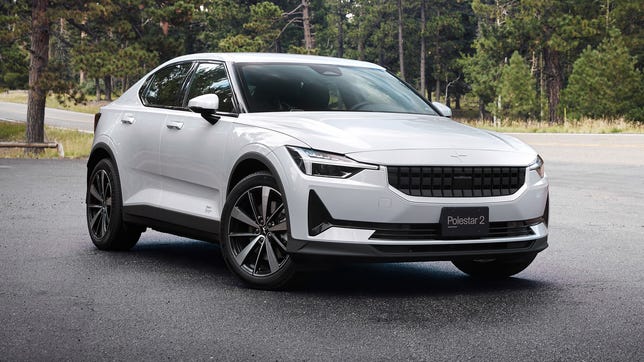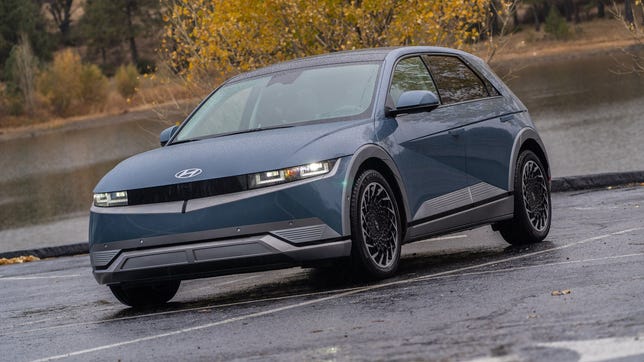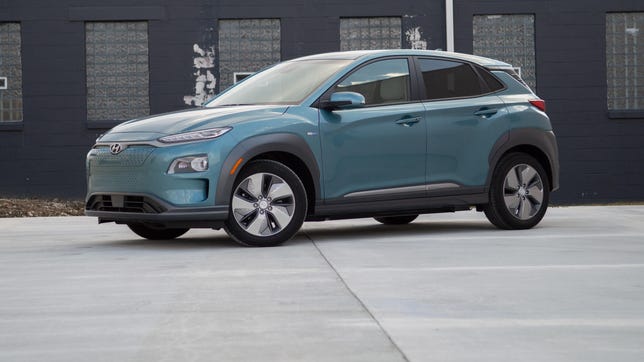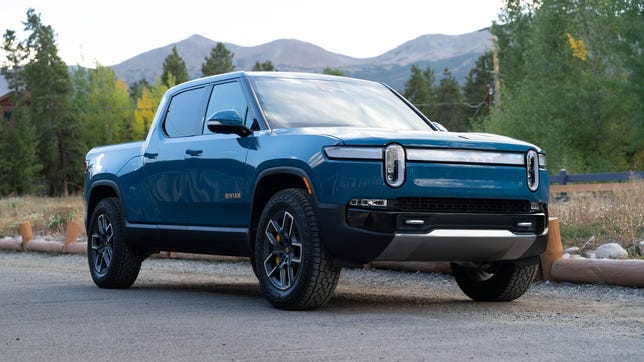
If you’re ready to shop electric cars, you’re in the right place. Our editors have driven nearly every new EV that’s currently on sale, and we’d love to help steer you in the right direction and choose the best electric car. After all, it’s not just Tesla selling EVs these days. There are various kinds of electric cars, and some may suit you better than others. But how are you supposed to choose the best one?
We can’t tell you exactly which EV is right for your life, but we can narrow your choices down. Do you want something cheaper and with a more limited range, or do you want to pony up some cash for luxury features and enough range for charge-free road trips?
We’ve driven just about every permutation of every current-production electric vehicle in the US today, so at CNET Cars we have a better-than-average view of what’s good and what’s not in EVs right now.
After taking a look at our recommendations, don’t forget to check out our tips below for buying your first EV.
Oh, and since we know a lot of you Tesla fans are wondering why we didn’t include anything from that brand here, it’s pretty simple. There’s a lot to like in the Model Y that we’re leasing (yes, we’re paying for it), but as we noted in our Model Y review, the phantom braking issue is a complete deal-breaker. As-is the car is unsafe and unpleasant to drive and we’ve heard from plenty of Model 3 owners with the same issue. Once Tesla issues a comprehensive fix, we’ll update our review and this list.
Polestar
A good electric car is more than just the sum of its parts. The Polestar 2 might not have the best specs in its segment, but it’s easy to love and it’s a great car in general.
We love the Polestar 2 for a variety of reasons. It’s sufficiently quick in its two-motor configuration, and no matter how many motors it has, the 2 is a hoot to drive. The styling is lovely inside and out. There’s also plenty of cool tech in here, including a Google-based infotainment system that ranks among our favorites. It may not have the longest range in the segment, but it’s endearing in so many other ways.
2022 Polestar 2 is cheaper to start but looks just as good
Mini
Mini might be new to the EV game, but the brand’s first effort is a great one. What it lacks in overall range, it makes up for in being fun to drive and great to be in, all at a surprisingly reasonable price. And we love those electrical outlet-style wheels.
The Mini SE may only do 110 miles to the charge, but with 181 horsepower and a boatload of torque in a small package, they’ll likely be 110 fun-filled miles. The good news is that on a 50-kilowatt fast charger, you’ll be able to get an 80% charge in around half an hour.
Antuan Goodwin/CNET Cars
We’d been waiting for a while to get our hands on a Hyundai Ioniq 5, and now that we’ve spent a good amount of time with one, we can’t wait to recommend it.
The Ioniq 5 is a midsize EV — don’t let its compact looks in pictures skew your notions of size. Riding on Hyundai’s E-GMP dedicated EV platform, which also underpins the Kia EV6, we found the Ioniq 5 a comfortable cruiser with a sufficient range and better looks than most other EVs. A digital key is standard, as are four USB ports on a slick sliding center console. There are plenty of active and passive safety systems on offer, including a HUD that rivals some luxury cars.
Andrew Krok/CNET Cars
Ford is also new to the dedicated EV platform game with the Mustang Mach-E, but it’s a stellar effort. Despite its controversial name, the Mach-E offers good range, a great interior and excellent driving dynamics in a practical package that also boasts 29 cubic feet of cargo space with all the seats up.
The Mach-E is currently available in several flavors. There are hotter (and more expensive) GT versions on offer, but even the base model is fun to drive and deserving of its Mustang badge. With 290 horsepower on tap in RWD form, or 346 hp in all-wheel drive trim, the Mach-E easily gets out of its own way. The chassis is great and the cabin is a pleasant place to be. The Mach-E is one of the best all-rounder EVs on sale now.
Steven Ewing/CNET Cars
On paper, the Porsche Taycan is kind of a tough sell. It’s expensive (it’s a Porsche, after all) and its range estimate looks straight-up bad. Driving a Taycan tells a completely different story and we’re confident that this is the best EV you can buy right now. Its real-world range is totally adequate for all but long road trips and its build quality and driving dynamics are basically unassailable.
Presently, the best you’re going to be able to do officially with a Taycan is 227 miles and that’s in the 4S trim with the performance battery option. Even if that were totally accurate in the real world, that’s still plenty for most people on most days. Even the base Taycan offers a driving experience that’s leaps and bounds beyond most other EVs on sale right now and does so with just 400 horsepower.
2021 Porsche Taycan is a good-driving EV in an awesome pink wrapper
Tim Stevens/CNET Cars
Just because the RS E-Tron GT rides on the same platform as the Porsche Taycan doesn’t mean they’re carbon copies of one another.
The RS E-Tron GT produces an impressive 637 hp and 612 lb-ft in its overboost mode, which is enough to reach 60 mph in a hair over 3 seconds. That might sound dramatic, but Audi has cooked so much refinement into this car that it simply feels cool and composed at all times, even when you’re hustling the heck out of it. Like the Taycan, the RS E-Tron GT isn’t exactly cheap, but you really do get your money’s worth.
GMC
Do you like being large and in charge? Well, there’s no electric vehicle that matches this description as well as the GMC Hummer EV.
We’ve only had a short time behind the wheel in a Hummer EV thus far, but what we have experienced left us with some good memories. In Watts to Freedom, or WTF, mode, its acceleration is damned impressive for something that could very well tip the scales at some 9,000 pounds. That can mess with your head, considering this thing is the size of a building. It’s awfully expensive right now, with Edition 1 models asking a woof-worthy $113,000, but if you wait until 2024, you can scoop up a lower trim for closer to $80,000.
Hyundai
Many people shopping for their first electric vehicle are going to be looking for something affordable. While EVs still haven’t reached price parity with internal combustion vehicles, there are tons of great examples under $50,000. Our favorite among these is the Hyundai Kona Electric. We picked the Kona because it offers great range, a practical small-SUV-style body and a stellar warranty.
The Kona Electric offers a super respectable range of 258 miles and a drivetrain that produces 201 horsepower, all in a package that will work for most families. It has a decent amount of cargo space — 19.2 cubic feet with all the seats up, to be specific — and because it’s a Hyundai, it also has tons of creature comforts as standard equipment. Don’t even get us started on the warranty. If you can live with the styling (we like it) and you can stretch your buck far enough, the Kona is an almost perfect first EV.
Andrew Krok/CNET Cars
The Volkswagen ID 4 might not have the sheer affordability factor the Hyundai Kona Electric does, but with a starting price that isn’t too far off, the ID 4 makes a solid case for itself.
The VW ID 4 sports some decently good looks for a crossover, with interesting forms on all sides. The interior is traditional VW in that it’s basic but there’s oodles of storage and the overall design is pleasant. You can get it with all-wheel drive, or keep things affordable with a rear-drive variant. The tech might be a little quirky, but the ID 4 remains an affordable EV.
Mercedes-Benz
After an early drive in the Mercedes EQS, we knew it would be a winner with buyers. After even more seat time, we walked away thinking the exact same thing, and that’s unlikely to ever change.
The Mercedes-Benz EQS is, simply put, an amazing electric luxury car. It takes all the coddling comfort found in the gas-powered S-Class and gives it a dash of electromobility. Even in its EQS450 Plus trim, there’s more than enough acceleration on tap, and it doesn’t mind tackling corners with aplomb — although an upcoming AMG variant does offer something sprightlier from the factory. And then there’s the tech, featuring the dashboard-spanning Hyperscreen, which needs to be seen to be believed.
Andrew Krok/CNET Cars
The Lucid Air is impressive in a whole bunch of ways. It may not have the automatic staying power of something like the Mercedes EQS, but Lucid’s clever engineering is not to be trifled with.
First and foremost, the Lucid Air is one of the longest-range EVs you can buy today, with a max range of 520 miles in the right specification. Throw in a whole load of solid design elements inside and out, mix that with a cushy ride quality and some comfortable seats, and you’ve got quite the luxury electric stew goin’. We’ll have to wait and see if Lucid can come through with its promise to deliver as many trims and configurations as it wants, but for now, we remain pleased with what we’ve experienced thus far.
Ford
Maybe you’re specifically shopping for an electric SUV. There just aren’t that many to choose from yet and many of those that are currently available are kind of small. That’s why we’re once again recommending Ford’s Mustang Mach-E. It offers plenty of cargo space, lots of room for passengers, a good range, great driving dynamics and good infotainment. It’s also priced very competitively.
Nothing is selling like SUVs these days, so Ford’s plan to make its first dedicated EV an SUV was a good one. It works out even better for the Blue Oval that the Mach-E is so damned nice to drive and easy to live with. Despite its rakish shape and sporty badge, the Mach-E should be a super practical midsize EV that almost any family would have no trouble living with. If you need something sporty, Ford even has you covered with a GT model that’s coming soon.
2022 Ford Mustang Mach-E GT and Performance Edition are wild electric horses
BMW
One thing we loved about the diminutive BMW i3 was its unique interior, complete with styling and material usage that was hard to top at its price — or higher. BMW has brought a lot of that spirit back with the iX SUV.
The iX’s bones include a composite spaceframe with carbon-fiber reinforced plastics, much like the i3 that came before it. Its funky exterior styling is somehow topped by the interior, which again picks up interesting new design elements and relies on warmer materials than we usually see in modern leather-loaded Bimmers. With a net output of 516 hp and 564 lb-ft, the iX is also a blast to drive.
2022 BMW iX is weird on the outside, cool on the inside
Antuan Goodwin/CNET Cars
Rivian beat the legacy automakers to market with the R1T electric pickup. Thankfully, in addition to being the first battery-powered light-duty pickup on the market, the R1T is also a great EV overall.
After tackling the Rebelle Rally in a specially outfitted R1T, we finally drove the R1T in more traditional settings late last year, and we walked away impressed. Its quad-motor layout generates some impressive acceleration, while its 314-mile battery isn’t too shabby for those looking at longer road trips. Whether in the dirt or on the road, the R1T impressed us with its ride and build quality. It’ll be interesting to see how the R1T stacks up once the legacy automakers get their electric trucks to market.
Porsche
Most station-wagon variants of the Porsche Taycan are of the Cross Turismo variety, which includes a ride-height lift and some additional cladding around the wheel wells. If you want a tried-and-true, low-to-the-ground wagon, though, your options are limited to one: the Porsche Taycan GTS Sport Turismo.
The Taycan GTS will be the only trim level in the US to wear the Sport Turismo configuration, which is fine, because it’s the only one we need. Like any other Porsche with a GTS badge on the back, this car hustles, and it beats the tar out of curvy roads like it’s getting paid to do so. And, like other Taycan models, the EPA-estimated range should be pretty easy to top.
2022 Porsche Taycan GTS Sport Turismo is a red-hot wagon
Rimac Automobili
Electric hypercars are slowly growing in number, but for now, if we had an infinite pile of money to spend on one, we’d be looking at the Rimac Nevera.
This Croatian electric hypercar offers some mightily impressive specs, including a four-motor powertrain that produces a prodigious 1,914 hp and 1,740 lb-ft. It’ll blast past 60 mph in less than 2 seconds while hustling to its 258-mph (!) top speed. Its 120-kWh battery pack should provide a range of about 300 miles in the US. It also helps that it’s a stunner inside and out. Then again, for $2.45 million, it’d better be.
Rimac Nevera electric hypercar has otherworldly performance and stunning looks
Ford
Legacy automakers have always cherished their light-duty pickup lineup, so it didn’t come as a surprise when Ford announced the F-150 Lightning. It’s not just an electric pickup, it’s loaded with tech and creature comforts that should appeal to buyers, and it should beat its primary competitors to dealership lots by years.
When the F-150 Lightning goes on sale in 2022, it will be offered with two different battery packs, offering a manufacturer-estimated range of 230 or 300 miles. Whereas one competitor is taking the moonshot approach, filling its first-year production queue with six-figure trucks loaded to the gills with stuff, the Lightning will be a bit more democratized, offering a variety of trims across multiple price points for buyers all across the socioeconomic spectrum. If you want to spend $90,000 on a Lightning, you can do that, too. Demand has been so strong for the F-150 Lightning that Ford has already announced — twice, even — that it will boost production to meet all the hand-raising. We’re stoked.
Comparison of the best electric cars for 2022
| Name | Max range (mi.) | Starting price | |
| Best small electric car | Polestar 2 | 270 | $47,200 |
| Best small electric car runner-up | Mini Cooper SE | 114 | $30,750 |
| Best midsize electric car | Hyundai Ioniq 5 | 303 | $40,925 |
| Best midsize electric car runner-up | Ford Mustang Mach-E | 305 | $44,995 |
| Best full-size electric car | Porsche Taycan | 227 | $84,050 |
| Best full-size electric car runner-up | Audi RS E-Tron GT | 232 | $143,445 |
| Best extra-large electric car | GMC Hummer EV | 350 (est.) | $79,995 (est.) |
| Best affordable electric car | Hyundai Kona Electric | 258 | $35,185 |
| Best affordable electric car runner-up | Volkswagen ID 4 | 260 | $41,955 |
| Best luxury electric car | Mercedes-Benz EQS | 350 | $103,360 |
| Best luxury electric car runner-up | Lucid Air | 520 | $77,400 |
| Best electric SUV/crossover | Ford Mustang Mach-E | 305 | $44,995 |
| Best electric luxury SUV/crossover | BMW iX | 324 | $84,195 |
| Best electric pickup truck | Rivian R1T | 314 | $68,575 |
| Best electric station wagon | Porsche Taycan GTS Sport Turismo | TBA | $134,650 |
| Best electric car if money is no object | Rimac Nevera | 300 (est.) | $2,450,000 |
| EV we’re looking forward to the most | Ford F-150 Lightning | 300 (est.) | $41,669 |
Consider this before buying an EV
Picking a car isn’t the only consideration when making the jump to an electric vehicle. Not being able to just zip over to the gas station around the corner does complicate things a bit, but we can help you with this too.
The first thing you should consider when shopping for an electric vehicle — hell, even before you start shopping — is figuring out how you’re going to charge it. The fact is that while every EV comes with an adapter that will let you plug into any old 110-volt outlet (in the US, anyway), the size of modern EV batteries means that you could spend days waiting for a decent charge.
If you own your own home, you’ll need to look into getting a Level 2 charger installed. Luckily, these aren’t that expensive on their own. While getting one put in does require a contractor’s services (these are dangerous voltages and currents we’re working with here), there can be tax breaks for doing so — especially if you decide to make the jump to solar at the same time.
Electrify America
If you don’t own your own home, you’ll be using a charging network. You should look into which ones are the most well-established where you live and drive most often. If you have a Tesla, this is pretty easy. If you have other EVs, you’ll have to do a little research, but the most common nonproprietary networks are Electrify America, Chargepoint and EVGo. They all have different apps and pricing, but they all work more or less the same. These charging networks will offer Level 2 charging or DC fast-charging. The latter is considerably more expensive, but it’s much faster.
The next thing to think about is maintenance and service. EVs, in general, require a lot less service than an internal-combustion-powered car. Still, if you have your heart set on a Tesla and you don’t live anywhere near a Tesla service center, you might end up in an inconvenient position should something break. In this case, maybe an EV from a more traditional brand would be better for you.
Ford
Tax incentives are an important part of many people’s decisions to switch to an EV, and that’s totally valid. It’s important, though, to understand that not all manufacturers qualify for all of the incentives (Tesla, notably), and not all buyers will be able to take advantage of the full federal incentive, even if it’s offered. It’s worth talking to a tax professional before factoring a $7,500 tax credit into your purchase — even if a manufacturer tries to include that in its advertised prices. Also, be sure to look into whether you might qualify for state and local tax incentives — don’t leave money on the table.
Finally, be prepared to talk about your electric car. People will ask you about it — friends, family and strangers — especially if you live somewhere EVs aren’t super common yet. Some of those questions might seem silly or even dumb, but you’re going to hear them, and depending on how you answer, you might just help convince those people that an EV could work for them too.

















